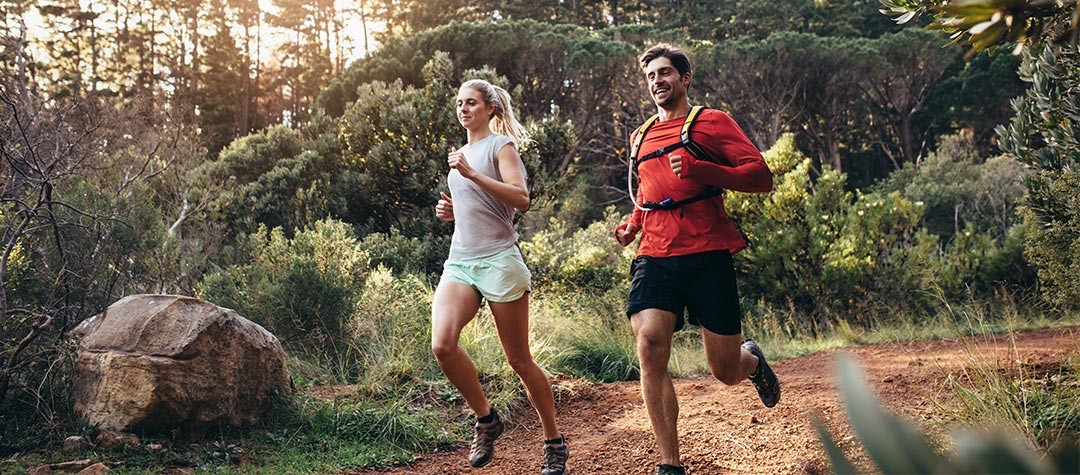Running in the outdoors on trails and tracks that are just as nature intended them is a world away from running on flat, tarmac roads. The skill set required just to stay on your feet is hugely different to running around a track or a town or city.
It’s important to think about the essentials for running safely, combined with a pragmatic approach to the distance you are going to cover, rather than your speed.
1. Footing
This is one of the most important skills you need to master. When you’re running on the flat on a road or pavement, the only hazard you’re likely to encounter is a protruding kerbstone. As a result, the chances of falling over something are fairly slight. But when you hit the trails and the parks, your speed reduces while your chances of a fall increase hugely. Suddenly you need to be on your guard for obvious and hidden obstacles, quick changes of direction, sharp elevations and descents, which mean you need to be ready to react fast.
Fix your gaze on the floor around six strides in front of you.
First things first, fix your gaze on the floor around six strides in front of you. You need to be able to see something coming up on the trail, from a rock to uneven ground, so that you can avoid it or hurdle it. If you are running a popular trail there may well be a well worn track where other runners have gone through. If there isn’t, look to plant your feet on firm ground or a solid looking rock or boulder. If the weather conditions haven’t been good, then the trail might be muddy or slippery with ice and snow, which will slow you down and force your body, limbs and major muscle groups to move at unnatural angles. So brace yourself, because your ankles will take a pounding and your core will also be working overtime to keep you stable and upright.
2. Sharp turns
This is something that road runners rarely need to navigate. But up in the mountains or the hills, your trail might suddenly veer either left or right to avoid a steep drop. Your lateral movement skills need to be honed so that you can move quickly in either sideways direction and maintain your running speed. It’s hard work moving in a way that your body might not be used to, so prepare for muscle fatigue, especially in the hips, core and legs. But strengthening exercises in those areas will definitely help.
3. Uphill climbs
Hill running is a fantastic addition to any runner’s training schedule because it improves your leg strength, leg speed, aerobic capacity and running economy. And hills are probably going to be on the agenda if you want to run off road.
The key to making a successful hill climb is to remember your technique.
The key to making a successful hill climb is to remember your technique.
A shorter, light, bouncing stride in a rhythmic fashion, powered by pumping arms will take you where you need to go. Lean slightly into the slope but keep your back straight and don’t over-rotate your torso, or you will expend energy you can’t afford to waste. You need to lift your knees a little higher than you would on the flat and keep taking steady deep, belly breaths to get the oxygen into your lungs. And remember, if you have to walk it, there is no shame in that at all.
4. Making a descent
Getting up an ascent is one thing, getting down is quite another. Sliding, running, falling, or indeed walking, are all options for descending a steep slope, with falling definitely not the preferred one. The most important thing to remember is not to lean back. If you lose control of your posture and technique you can easily take a nasty tumble. Don’t run too fast either, as control could easily be lost there too. Keep your eyes on the terrain and maintain a steady pace and remember that your hips, quads and ankles will be taking a huge pounding as they cope with impact absorption and deceleration.
It’s a huge workload, so go easy. If it’s a really steep slope, run it from side to side in a zig zag, to slow down. If you find you are starting to career out of control, jump into the air, it will slow you down. If there’s snow and ice on the ground, zig zag your way down slowly, sliding if you have to.
5. A lack of rhythm
One of the most startling aspects of this kind of running is the lack of rhythm. When you’re on the flat you’re able to check in with yourself regularly and move up or down a gear fairly effortlessly, because you know how much energy you’re expending and how much you have left. It’s harder to make that assessment when you run off road. You need different fitness levels to take on the hills and descents, as well as the relentless grind of battering your limbs on uneven surfaces. Runners who have fartlek sessions under their belt, as well as sprint work, tend to cope better with this kind of workout because they have the experience of work at various speed levels. But an ability to treat flatter sections of your route as a recovery run will stand you in good stead as you push yourself to the limit.















